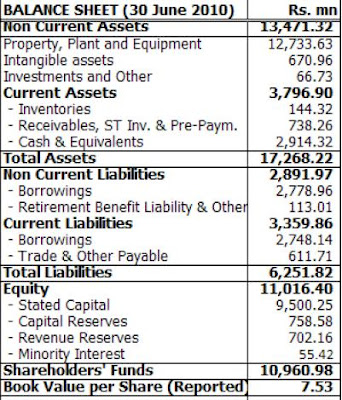Hatton National Bank's (HNB) net profit has grown 23% YoY to LKR1,220.3 mn in 2Q2010 mainly on the back of a 7% YoY increase in net interest income, 25% YoY increase in non interest income and a 94% YoY reduction in provisioning cost which enabled 1H2010 net profit to grow by 10% YoY to LKR1,888.5 mn. With the economy expected to grow by circa 6%-7% during the next few years and contributions from the previously war affected North and East to the main stream economy the banking sector outlook remains positive with loan growth (grew 2.2% YoY in May) expected to gather momentum from 2H2010 with the low interest rate environment. HNB's net interest margins are expected to be intact at around 5%, whilst continuing to benefit from the wider reach facilitated by 189 branches (20 branches in the North and East) and higher retail focus.
However, we maintain our forecast 2010E net profit at LKR4,101.0 mn (down 9% YoY)with slower credit growth in 1Q2010 than anticipated coupled with high operating costs and projected 2011E net earnings at LKR4,547.8 mn (up 11% YoY).
The voting share is fairly valued at 17.0x forecasted 2010E profit and 15.3x on forecast 2011E whilst trading 2.4x PBV. The non voting share remains attractive on 11.0x forecast 2010E net profit and 10.0x projected 2011E net earnings whilst 1.5x PBV. Maintain BUY.
Interest income has dipped 16% YoY to LKR7,576.7 mn in 2Q2010. HNB’s interest income has dipped 15.6% YoY to LKR7,576.7 mn in 2Q2010, mainly due to a 19.4% YoY dip in interest income from loans and advances to LKR5,827.8 mn. The dip in interest income from loans and advances was on the back of low rates despite performing loans growing by 4.4% during the quarter to LKR164.2 bn. However interest income from fixed income securities remained flat at LKR1,748.8 mn even though treasury bill and bond portfolio (held to maturity) grew by 9.5% to LKR61.6 bn during the quarter which is approx. 21% of the banks’ total asset base.
Interest expenses dipped 31% YoY to LKR3,714.1 mn in 2Q2010. Group’s interest expenses have dipped 30.9% YoY to LKR3,714.1 mn in 2Q2010, on the back of 30.5% YoY drop in interest cost on deposits to LKR3,295.5 mn. The drop in deposit cost is largely attributable to low deposit rates and the shift in the deposit mix from high cost time deposits to low cost CASA products (CASA mix improved to circa 50% of total deposit base from 48% in 1Q2010). Further deposit base also recorded a marginal 1% growth to LKR216.4 bn during the quarter. Interest expenses on other interest bearing liabilities also dipped by 34.3% YoY to LKR418.7 mn.
Net interest income grew 7% YoY to LKR3,862.6 mn. The dip in interest income was off set by a faster decline in interest cost enabling net interest income to grow by 7.1% YoY to LKR3,862.6 during 2Q2010. Interest margins also improved to 5.3% (up 1.3% QoQ) in 2Q2010.
Non interest income grew 25% YoY to LKR2,000.6 mn in 2Q2010. Non interest income has grown by 24.8% YoY to LKR2,000.6 mn in 2Q2010 due to 31.6% YoY increase in other income to LKR1,764.1 mn. Other income growth was supported by the capital gains made by selling off shares it held in Commercial bank and Distilleries.
Foreign exchange income fell by 9.7% YoY to LKR236.5 mn, due to stagnant exchange rates.
Operating cost has increased by 13% YoY in 2Q2010 to LKR3,400.2 mn. Operating costs have risen by 12.6% YoY to LKR3,400.2 mn, mainly due to a 17.7% YoY increase in personnel costs to LKR1,283.4 mn. Increase in personnel cost was a result of salary revision undertaken across all staff grades of the bank during 2009. Consequently the operating cost per branch stands at LKR18.0 mn per quarter and the cost to income ratio is at circa 58%.
Provisioning cost has dipped 94% YoY to LKR 10.0 mn in 2Q2010. Total provisions have dipped 94.0% YoY to LKR10.0 mn, mainly due to a 160.0% YoY improvement in recoveries and 50.8% reduction in specific provisions. Gross NPL ratio for HNB is at 6.5% (compared to 7.4% in 1Q2010) and net NPL ratio stands at 3.3%. HNB’s non performing loans reduced by 8.0% to LKR13.4 bn during the quarter and the provision cover stood at 42%. (compared to 39% in 1Q2010).
Total tax bill has risen 13% YoY to LKR1,217.9 mn in 2Q2010. Value added tax (VAT) has increased by 19.5% YoY to LKR630.4 mn and corporate tax increased 7.1% to LKR587.5 mn pushing up the total tax bill (VAT and Corporate tax) by 13.2% YoY to LKR1,217.9 mn in 2Q2010. Thus the effective tax rate of the bank is near 50% in 2Q2010.
Net profit up 23% YoY to LKR1,233.1 mn in 2Q2010. Consequent to a 7% YoY increase in net interest income, 25% YoY increase in non interest income and a 94% YoY reduction in provisioning cost helped HNB’s profitability in 2Q2010. Cumulative 1H2010 profits also rose 10% YoY to LKR1,870.1 mn.
Forecast 2010E net profit maintained at LKR4,101.0 mn (Down 9% YoY). With the economy expected to grow by circa 6%-7% during the next few years and contributions from the previously war affected North and East to the main stream economy, the banking sector outlook remains positive where loan growth expected to gather momentum from 2H2010 onwards with the low interest rate environment. HNB’s net interest margins are expected to be intact at around 5%, whilst continuing to benefit from the wider reach facilitated by 189 branches (20 branches in the North and East) and higher retail focus (Retail mix is circa 60%).
However, we maintain our forecast 2010 net profit at LKR4,101.0 mn (down 9% YoY) with slower credit growth in 1Q2010 than anticipated (private sector credit growth in January 2010 was 0.6% MoM and 1.6% MoM in February 2010) coupled with high operating costs. However we expect 2011E net earnings to grow by 11% YoY to LKR4,547.8 mn on the back of loan book expansion (where the private sector credit is expected to grow from 2H2010 onwards) and cost rationalisation strategies expected to be adopted by the bank.
The voting share is fairly valued on 17.0x forecast 2010E net profit. The voting share is trading at 17.0x forecasted 2010E profit and 15.3x on forecasted 2011E whilst trading 2.4x PBV.
The non voting share remains attractive on 11.0x forecast 2010E net profit and 10.0x projected 2011E net earnings whilst 1.5x PBV. Given the stable macro economic outlook and expected credit growth HNB, is in a better position to reap the benefits out of it with its island wide coverage (has the largest presence in North and East). Further HNB’s new branches (specially in North and East) breaking even in the coming years will contribute positively to banks bottom line. Bank also has a divesified product portfolio where they aggressively look at growing areas such as foreign worker remittences, credit card business and pawning. Further we believe HNB would adopt necessary measures to curtail its costs with its newly adopted core banking system in the future. Thus we Maintain BUY.






































